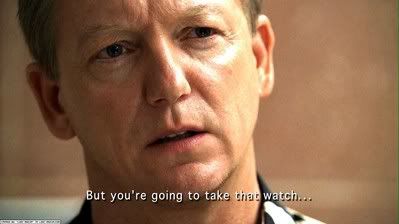Okay, science and philosophy fans, this one's for you. For some time, we've puzzled over the appearance of various Island elements (e.g., the Numbers, Kate's horse, the Dharma octagon, etc.) in the flashbacks of our Losties. One plausible explanation is that they're the victims of an elaborate conspiracy that brought them to the Island. I agree there's a conspiracy afoot but don't believe it explains the foregoing things. My paradoxical speculation is that the survivors of Oceanic 815 brought themselves to the Island, which is why it looms so large in their respective pasts. To understand how, let's begin with Desmond's namesake, Mr. David Hume.
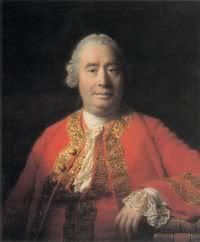
Hume was an empiricist and believed that we can only know what experience tells us. One of his great philosophical contributions was the notion that causation is really nothing more than our observation of the conjunction of two events. We see A followed by B enough times and infer that there must be a necessary connection between them -- i.e., A causes B. Hume argued that this inference was faulty no matter how often A is followed by B. Constant conjunction is not synonymous with necessary connection. Hume's claim is pretty wild when you think about it. He basically argued that there's no reason beyond our own experience to think the sun will rise tomorrow.
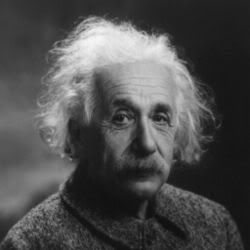
Fast forward several centuries to Albert Einstein, whose general theory of relativity threw a further wrench in the causation works. Einstein established that mass literally warps the geometry of spacetime, giving rise to gravity. It turns out that some valid mathematical solutions of general relativity involve "closed timelike curves," allowing for at least the theoretical possibility of travel into the past. To see why, imagine yourself at the intersection of two vast cones of light. The cone behind you represents all of the past events that could have had some causal effect upon you. Ahead of you is a cone of all possible events that you could affect in the future.
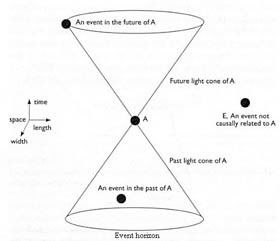
Ordinarily, these past and future light cones point away from each other in spacetime, thus preserving the illusion of history. In theory, however, some strange warp or wrinkle in spacetime could cause your future cone to tip such that it loops around and intersects with the past, creating the aforementioned closed timelike curve. Princeton astrophysicist J. Richard Gott (who also claims to have calculated the time left before humanity's extinction) analogizes such loops in spacetime to Magellan's circumnavigation of the globe or an MC Escher painting. The result is that one can -- again, in theory -- have a causal effect on events in the past.
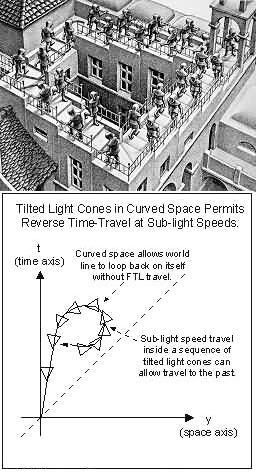
When Desmond activated the Fail-Safe he created such a closed timelike curve by briefly projecting his consciousness through time. His past and future perspectives merged momentarily, leaving him with a kind of temporal "double vision" that permits him paradoxically to remember the future. Desmond's brief flashes of future events are the product of his mind making sense of these dual perspectives a bit like how your brain processes two different images to create a 3D stereogram. The result is an enhanced perception of time that Crimson Rabbit analogizes to Dr. Manhattan's 4D perspective in Watchmen and that Zombie Soiree terms the "4D Eye."

What's more, I think everyone on the Island during activation of the Fail-Safe was affected to varying degrees by their proximity to that event. Eko and Locke were closest to ground zero and probably experienced similarly strong reverse causality. Unlike Desmond, of course, Eko and Locke didn't travel consciously through time. As Doctor Hanso notes, however, Locke experienced prophetic dream visions immediately following activation of the Fail-Safe and may have affected the past to make Anthony Cooper come out of the Box. I also wonder if the drug plane's presence can similarly be explained as Eko somehow influencing past events to effectuate the present.
All of which brings me back to my core premise that the survivors of Oceanic 815 brought themselves to the Island. Unlike Desmond, Eko, and Locke, these folks were further away from ground zero, lessening the affect of the Fail Safe upon them. None of our other Losties traveled consciously through time, and my guess is their impact on history was more limited. The principal manifestation is a subconscious attraction to each other and certain Island symbols. That's why their flashbacks contain so many improbable inter-personal connections and coincidences involving the Numbers -- future events are paradoxically causing subconscious effects in the past.

The analogy is to one of my favorite episodes of Star Trek: TNG, also titled "Cause and Effect." The Enterprise gets caught in a temporal causality loop where events repeat themselves, culminating each time in a catastrophic collision that resets the loop and erases any conscious memory of what's happened. Crew members realize something is wrong when they have apparent flashes of the future (e.g., what cards will be dealt in a poker game) and hear whispers that turn out to be echoes of past iterations. In an effort to break free, they send a subconscious clue to themselves in the past using Mr. Data whose positronic brain can detect "dekyon" transmissions. Data isn't consciously aware of the message -- it's more like post-hypnotic suggestion. For example, as the dealer in the aforementioned card game, he stacks the deck without even realizing it, dealing all 3s instead of the cards the characters expect. Ultimately, this provides the clue that allows them to break out of the loop.
I'm not convinced our Losties are/were caught in such a temporal causality loop, though Danielle's automated distress would work well as a metaphor for that effect. I do, however, think that time on Lost is circular -- i.e., past, present, and future exist simultaneously ala Aboriginal Dreamtime. As a result, it's possible for characters to contact (and perhaps even meet) versions of themselves from other points along the timeline. The Fail-Safe basically blasted our characters thoughts and experiences into the past like the Dekyon transmission in Cause and Effect. As a result, they were left with a kind of post-hypnotic suggestion that draws them unconsciously to each other, various Island symbols, and ultimately the Island itself. That's why these elements recur with such frequency in their flashbacks.
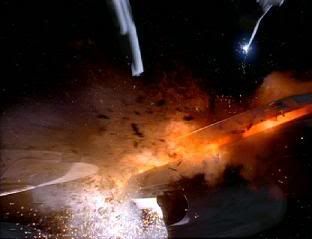
At this point, you may be wondering whether the very paradoxical character of such a reverse-causation scenario renders it impossible by definition. Thanks to Hume, however, we can't rule out causal paradox on metaphysical grounds. Accordingly, most scientists believe that the physical universe operates somehow to prevent or otherwise correct for paradoxes in the timeline. One famous speculation in this regard is Stephen Hawking's Chronology Protection Conjecture, which holds that the laws of physics prevent backwards time travel at all but microscopic scales, thereby foreclosing any possibility of temporal paradox.
Hawking uses the metaphor of a Chronology Protection Agency, "which prevents the appearance of closed timelike curves and so makes the universe safe for historians." An alternative approach is the Novikov Self Consistency Principle, which permits backwards time travel at the macroscopic level, but posits that the universe self-corrects against any alterations to the past that would yield causal paradoxes. A third solution relies upon the many worlds interpretation of quantum mechanics, positing that any changes to the past occur in alternate or parallel histories, thus resolving any apparent paradoxes.
Then there's the view on Lost, articulated by a character aptly named Ms. Hawking, who preaches a variation of the Self-Consistency Principle like a Chronology Protection Agent come to life. According to her, "the universe, unfortunately, has a way of course correcting." I take this to mean that Des is now part of a closed timelike curve caused by his activation of the Fail Safe. If he chooses not to go to the Island, press the button, and turn the key, the result will be major causal paradox, triggering a catastrophic course correction in which "every single one of us is dead." At least, that's what Ms. Hawking wants Desmond to think -- I'm not convinced she's being entirely truthful.
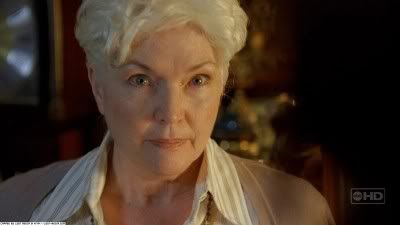
That's where the conspiracy I mentioned previously comes into play. I think the fallout from activation the Fail-Safe mirrors that from the Incident years before. Like Desmond, the Swan scientists traveled consciously through time. Unlike activation of the Fail-Safe, however, the Incident radically altered history -- apparently for the worse. Casual Mark Wickmund in a turtleneck became authoritarian Marvin Candle in a lab coat. These changes sent ripples throughout the timeline, resulting in a whole new future. Chronology Protection Agents like Ms. Hawking, who may well hail from this new future, are fighting to preserve it from disruption by the Fail-Safe.
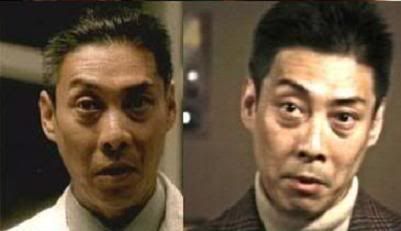
It may even be that the Fail-Safe was supposed to be a kind of course correction for the Incident. Perhaps the Chronology Protection Agents intervened, preventing major alterations by somehow cheating fate. I wonder, for example, if the second wreck of Oceanic 815 was staged as part of the effort to incorporate the crash into history while minimizing any ripple effects on the future. Even so, the Fail-Safe remains a dangerous point of instability in the timeline that can't be erased without having further deep chronological impacts. Thus, the Agents now have strong incentive to ensure that nothing upsets this particular aspect of history, as well.
That's why, while I maintain our Losties brought themselves to the Island, I think the Chronology Protection Agents were probably watching most of the way, poised to intervene if anyone pulled a Desmond. In fact, I believe we've met at least two other Agents besides Ms. Hawking. One was Brother Campbell, who had a picture of Ms. Hawking on his desk. And the other? That would be the guy in the Hawaiian shirt who accosted Jin in the airport restroom just as the latter was considering running off with Sun instead of boarding Oceanic 815. Dude spoke creepily perfect Korean and claimed to work for Mr. Paik, but my guess is that Hawaiian-shirt guy was a Chronology Protection Agent.
